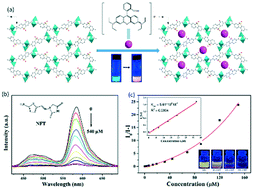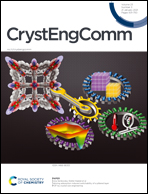Fabrication of a dual-emitting RhB@Zn-1 composite as a recyclable luminescent sensor for sensitive detection of nitrofuran antibiotics†
Abstract
A novel 3D anionic porous metal–organic framework {[(CH3)2NH2][Zn3(μ3-OH)(L)2(H2O)]·4H2O·3DMA}n (Zn-1) (H2L = 1-hydroxy-5,5-dioxodibenzothiophen-3,7-dicarboxylic acid, DMA = dimethylacetamide) has been solvothermally synthesized. Single-crystal X-ray analyses reveal that the framework of Zn-1 is based on deformed triangular [Zn3O] clusters with interlinked 1D channels. Taking advantage of the high porosity and charged skeleton of Zn-1, fluorescent dye rhodamine B (RhB) molecules can be successfully incorporated into the channels of Zn-1via an ion-exchange process. Due to the spatial confinement, the RhB@Zn-1 composite shows dual-emission properties including the emissions of Zn-1 centered at 475 nm and RhB centered at 580 nm. Moreover, RhB@Zn-1 can be used as a recyclable fluorescent sensor for sensitive and selective detection of nitrofuran antibiotics (nitrofurantoin and nitrofurazone), with high KSV values (5.61 × 104 M−1 and 4.73 × 104 M−1) and low detection limits (0.73 μM and 0.86 μM). Comparison experiment results show that the sensing capability of Zn-1 can be greatly improved via the dye-encapsulation strategy. Further studies reveal that the synergistic effect of competitive absorption and photo-induced electron transfer causes the fluorescence quenching of Zn-1, which in turn decreases the energy transfer from Zn-1 to RhB and leads to the quenching process of RhB.

- This article is part of the themed collections: Coordination Networks and Editor’s Collection: Bio-applications of MOFs


 Please wait while we load your content...
Please wait while we load your content...